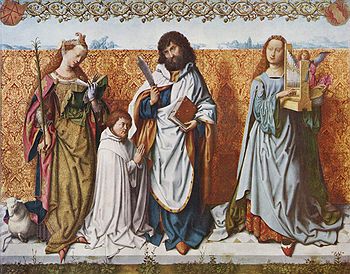
Back Meister des Bartholomäus-Altars German Majstro de la Bartolomeo-Altaro Esperanto Maître du Retable de saint Barthélemy French Maestro dell'Altare di san Bartolomeo Italian Meester van het Bartolomeüs-altaar Dutch Mistrz Ołtarza św. Bartłomieja Polish Mestre do Altar de Bartholomäus Portuguese

The Master of the Saint Bartholomew Altarpiece (sometimes called the Master of the Saint Bartholomew Altar[1]) was an Early Netherlandish painter active in Germany, mostly Cologne, between 1475[1]/1480 and 1510.[2] Despite his anonymity, he is one of the most recognizable artists of the early Renaissance period in German art.[3]
It has been said that the Master is the last "Gothic" painter to be active in Cologne. Approximately twenty-five paintings have been attributed to him[1] on the basis of his highly individual style, which does not seem to bear any affinity to that of any other school then active locally.[2] Despite the fact that he seems to have been the leading painter of his time in Cologne, no evidence of any followers, or of a school in the usual sense, may be found.[1]

A number of influences, mainly Netherlandish, have been traced in the Master's paintings. These include Dirck Bouts and Rogier van der Weyden,[4][5] whose influence may be seen in the Munich Madonna and Child with Saint Anne. Stylistically, the Master's paintings are characterized by their use of bright, enamel-like colors[5] and an affinity to the International Gothic style of painting.[6]
- ^ a b c d NGA
- ^ a b Getty
- ^ The modern monograph is Rainer Budde and Roland Krischel, eds. Genie ohne Namen. Der Meister des Bartholomäus-Altars (2001), based on an exhibition at the Wallraf-Richartz Museum.
- ^ WGA
- ^ a b Cartage Archived 2007-03-25 at the Wayback Machine
- ^ Cite error: The named reference
Wikiwas invoked but never defined (see the help page).
© MMXXIII Rich X Search. We shall prevail. All rights reserved. Rich X Search